|
End of Menu Items |
Report on KMJ 533's trip to the English Lakes
and back again
by Philip Waltham
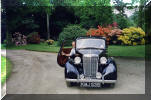 We have just completed a short four-day tour of nine hundred and fifty miles from South Norfolk to the Lake District with touring in the dales and hills around Dent and Dentvale in Cumbria. Much of the mileage was on the M.6 and some included very steep gradients in the dales. I enclose information from both so that YB owners
may compare benchmarks. The car, KMJ 533, is fitted with the "improved profile" Brown and Gammons steel cam, cam followers and pushrods with all new timing gear. The head has all new valves and springs but the original guides and oil seals. 8.25:1 pistons have raised the compression. I have broken all the rules and for the sake of quietness run with 13 thou tappet clearance. In five thousand miles this has not given any problem and compression and starting are fine. The distributor and carburettor are original but the
distributor cap, which is new, has some movement so that retaining the set timing is decidedly iffy. Despite all efforts and needles the mixture remains defiantly rich. The clutch is new. Gearbox synchromesh is good with a very smooth change under normal circumstances but the front main gearbox bearing is noisy on the overrun. The brakes have new linings and the drums are not scored. The car is fitted with radial ply tyres, which are unworn.
We have just completed a short four-day tour of nine hundred and fifty miles from South Norfolk to the Lake District with touring in the dales and hills around Dent and Dentvale in Cumbria. Much of the mileage was on the M.6 and some included very steep gradients in the dales. I enclose information from both so that YB owners
may compare benchmarks. The car, KMJ 533, is fitted with the "improved profile" Brown and Gammons steel cam, cam followers and pushrods with all new timing gear. The head has all new valves and springs but the original guides and oil seals. 8.25:1 pistons have raised the compression. I have broken all the rules and for the sake of quietness run with 13 thou tappet clearance. In five thousand miles this has not given any problem and compression and starting are fine. The distributor and carburettor are original but the
distributor cap, which is new, has some movement so that retaining the set timing is decidedly iffy. Despite all efforts and needles the mixture remains defiantly rich. The clutch is new. Gearbox synchromesh is good with a very smooth change under normal circumstances but the front main gearbox bearing is noisy on the overrun. The brakes have new linings and the drums are not scored. The car is fitted with radial ply tyres, which are unworn.
KMJ 533 gave an average consumption of 27.8 per gallon (unleaded) but this includes fast motorway work and four very long traffic queue crawls totalling two hours on the M.6 and A14. Oil consumption was disappointing as we used a full litre of 10/40 semi-synthetic oil. As said the car has new bores and pistons but the valve guides have not been replaced (65,000 miles) and the sump, after much careful fitting, has reverted to the usual generous chassis oil spray.
I intended to cruise at 50 — 55 and began with measurement by watch, motorway posts and odometer to discover the speedometer error. This turned out to be a staggering 12.5% ahead of the true speed, possibly partly because of the radial ply tyres. Once I had found that figure I could of course make allowances and read the true speed more accurately. Because of the long straight stretches on the A14 and M6 I was able to establish the best cruise in terms of smoothness and quietness. Much to my surprise this was just above 60 m.p.h. or around 4,250 r.p.m. Before the run I had been sure this was too much for this long stroke engine but it ran very sweetly and gave no indications of stress at all. In fact it was difficult to hold back although I did not allow it to rise above 65 m.p.h. or 4,600 r.p.m. when overtaking. The engine is bored to plus 30 thou and fitted 8.25:1 pistons but the crank is original (65,000 miles) although with new mains and big ends. Max oil pressure is just fifty cold and normally runs at around 40 p.s.i., but it fell on the long stretches to around 35. The saving grace was that it did not fall further, but held rock steady at that. Tick over held at around 10 lbs. At first I was worried by the low oil pressure but as it was absolutely solid at 35 and fell no further and the engine gave no sign of bearing distress or knock, I decided all was well and simply ran with it. I listened for the bearings especially when starting but heard no knock at all. I did slip the car out of gear on some longer downhill stretches of the A14 and M.6 to give time for the oil to collect and possibly cool a little but that made little or no difference to the pressure. Parking for a 30-minute lunch did bring it back to cold figures but as the car cruised so they fell again to 35. The radiator did not get hot and the water level remained constant.
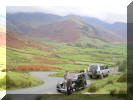
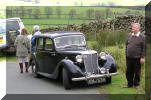 The steep inclines of the dales gave the car and myself a tremendous challenge and I had to use first very frequently. I will explain that in addition to luggage KMJ was carrying four average size adult passengers. The gearbox did not change into first easily even using double-declutch, but this is perhaps more a comment on my deteriorating driving skills than the car. The problem was that I did not wish to stop, and was engaging first while the speed was rapidly degrading. After a while the old techniques returned and I was able to keep the speed up in second but not when very tight bends or other traffic held me back. The car never let us down but I did find that sometimes it simply would not pick up when under load on a steep gradient. Sadly the only way out seemed to be to move off with more revs than I would have liked. Luckily the new clutch showed no sign of distress and the back axle seemed to take the extra load, but I would not like to do that every day. I have to admit that when the load was reduced to two adults the car was much more sprightly and well up to what was needed on those difficult roads. The brakes were superb throughout and gave no problem on the steepest of inclines where they were sensitive and powerful. The handbrake held without problem so assisting difficult hill starts, which made driving much easier. The brakes are the greatest difference between the YB and the YA, which
I used to run, NO BRAKE FADE!
The steep inclines of the dales gave the car and myself a tremendous challenge and I had to use first very frequently. I will explain that in addition to luggage KMJ was carrying four average size adult passengers. The gearbox did not change into first easily even using double-declutch, but this is perhaps more a comment on my deteriorating driving skills than the car. The problem was that I did not wish to stop, and was engaging first while the speed was rapidly degrading. After a while the old techniques returned and I was able to keep the speed up in second but not when very tight bends or other traffic held me back. The car never let us down but I did find that sometimes it simply would not pick up when under load on a steep gradient. Sadly the only way out seemed to be to move off with more revs than I would have liked. Luckily the new clutch showed no sign of distress and the back axle seemed to take the extra load, but I would not like to do that every day. I have to admit that when the load was reduced to two adults the car was much more sprightly and well up to what was needed on those difficult roads. The brakes were superb throughout and gave no problem on the steepest of inclines where they were sensitive and powerful. The handbrake held without problem so assisting difficult hill starts, which made driving much easier. The brakes are the greatest difference between the YB and the YA, which
I used to run, NO BRAKE FADE!
Despite all my many previous miles in KMJ I was still surprised at the smooth and trouble free running of this small car. I was astonished at the high cruise speed and very pleased with the sweet precise handling and good braking. Problems are a slight vibration below 55 and this is a little annoying. It does not come up through the column, gear lever or dash panel but is chiefly felt through the floorboards. Any advice on or experience with this problem would be most welcome. I would welcome too thoughts on the closed tappet tolerances and reduced oil pressure although neither seems to be the problem that one might expect. Strangely the car was not noisy by the standards of its day although of course it is noisier than a modern counterpart. The carburettor does boom at the higher revs (4,500 plus) but I simply keep below that and feel grateful for the audible warning of over revving!
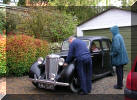
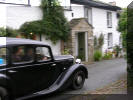 So once again the YB showed itself to be a thoroughly workmanlike car with lots of good features and very few bad ones. I would perhaps mention that the small front seats were difficult to doze in when I tried to sleep on the return journey while my wife drove and I would not like a long journey in the passenger seat. The answer would be, I suppose, to sit in the back to rest. Luggage space is better than it at first appears and the boot is sufficiently roomy for luggage for two. The ride is smooth and firm and was in fact less sick-inducing on the dales roads that the modern car which our friends used. I feel the petrol consumption is high and wonder about that. Obviously the fitting of new valve guides and modern valve seals would reduce the oil loss, as would some reliable system of sealing the sump. I found no difficulty when using the trafficators and have never had an incident because of them so I am not inclined to introduce flashers to an otherwise original motorcar. Modern speed wipers would be good but again I am loath to interfere with the originality of this particular machine.
So once again the YB showed itself to be a thoroughly workmanlike car with lots of good features and very few bad ones. I would perhaps mention that the small front seats were difficult to doze in when I tried to sleep on the return journey while my wife drove and I would not like a long journey in the passenger seat. The answer would be, I suppose, to sit in the back to rest. Luggage space is better than it at first appears and the boot is sufficiently roomy for luggage for two. The ride is smooth and firm and was in fact less sick-inducing on the dales roads that the modern car which our friends used. I feel the petrol consumption is high and wonder about that. Obviously the fitting of new valve guides and modern valve seals would reduce the oil loss, as would some reliable system of sealing the sump. I found no difficulty when using the trafficators and have never had an incident because of them so I am not inclined to introduce flashers to an otherwise original motorcar. Modern speed wipers would be good but again I am loath to interfere with the originality of this particular machine.
I commend this M.G. to all who are thinking of taking up the marque. The YB is easy to maintain and a delight to drive. I close by saying that little compares with the joy of sitting behind that neat and elegant straight bonnet or walking out to a parking area and seeing the well balanced lines of this graceful little motor car amid the more bland designs of today.

